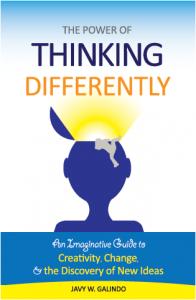Graduate Thesis Prospectus by Javy W. Galindo
My research topic pertains to understand the mechanisms of the mind involved in the creative thinking process and in attaining conscious awareness of creative insights, unique ideas, and unconventional solutions to problems.
This study will consist of two major topics of inquiry. One, it will consist of an exploration of cognitive science in order to better understand the nature of common sense, reason, and creative thinking. Second, the study will include a survey of popular notions, and real life examples of the creative process in order to more fully constellate the nature of imaginative, inventive, innovative, and ingenious thinking.
My research expectations are four fold. To begin with, I expect to find that rather than being purely objective and rational, human beings have filtered, limited perceptions, and react to the world through quick discernment mechanisms based on habitual pattern recognition. Secondly, I expect to discover that the means to transcend these limited perceptions — creative thinking — is a skill all human beings are equipped with from birth, and that the creative process can be expressed figuratively as a heroic journey that is accessible to anyone who desires to participate in it. In addition, I expect to find creative insight to be a scientifically valid form of attaining knowledge, and that a sense of play, a sense of humor, a child-like attitude of exploration, diversity of perspectives, mythology and stories, and many spiritual practices are critical for exercising our creative faculties. Lastly, I expect to uncover that creative thinking has been a relatively recent cognitive development crucial to our survival as a species, but has modern significance to all aspects of life including art, business, technology, scientific advancement, education, community affairs, personal development, and in the deepening of both a personal and cultural sense of meaning.
The existing literature pertaining to my study of cognitive science includes An Anatomy of Thought by I.Glen (1999), an investigation of neural networks and their role in our perception and information processing. In The Wisdom Paradox (2005), E. Goldberg presents a more recent account of neural networks, neuroplasticity and the role of the two hemispheres in our ability to learn and think novel thoughts as we age. R. Restak provides many research results concerning the brain’s ability to rewire itself in his book The New Brain (2003). The role of the right hemisphere in non-literal processing and in the processing of context is explored in The Right Mind (1997), a book by Robert Ornstein. In The Psychology of Consciousness (1986), Ornstein also provides a psychological account of paradigms and the mind’s propensity for automatic responses based on pattern recognition. Paradigms are further explored in Brain and Culture (2006) by B.E. Wexler, as he explores the relationship between neurobiology and our ideology, and what this means for affecting social change.
The existing literature also addresses the cognitive science of creativity directly through such books as N.C. Andreasen’s The Creating Brain (2005), which explores the relationship between neural networks, creativity, and unconscious thought processes that occur within the association cortex. Creativity is further investigated through a computational neuroscientific lens in M.A. Boden’s book The Creative Mind (1991), as she takes a look at how computer scientists model creativity in computers. E.D. Bono provides an explanation for why we have difficulty finding unique ideas and solutions, and provides specific strategies for discovering creative insights in his books New Think (1968), Lateral Thinking (1973) and I Am Right, You Are Wrong (1991).
The artist’s perspective of the creative process is explored in existing literature such as The Artist’s Way (2002) by J. Cameron, How To Play Jazz and Improvise (1992) by J. Aebersold, The Creative Habit by T. Tharp, and Point Zero (2001) by M. Cassou. D. Wakefield explores the creative process through a spiritual perspective in his book Creating From The Spirit (1996). Similarly, T. Crockett reflects on indigenous methods for access the creative spirit in his book The Artist Inside (2002). A survey of individuals and their creative process was compiled across disciplines and is reflected upon in Creativity (1996), by M. Csikszentmihalyi. And, in the book The Creative Process (1985), B. Ghiselin investigates the creative process of famous writers, scientists, and many other notable creative thinkers.
Biases I bring to this inquiry and that I will need to bracket as carefully as possible includes a predisposition towards linear/rational information processing, and a propensity towards literalism. My plan for turning these potential shortcomings into strengths is to acknowledge them, be cognizant of them as I interpret my research data, and use myself as a guinea pig in testing the efficacy of the research material.
Where our more common thought processes have propelled many of us into a world of full of conflict, stress, meaninglessness, and growing global dilemmas, a new approach to thinking may be necessary. Through my research, I hope to provide a guide to how human beings can exercise our ability to think differently in order to be more conscious of novel ideas, creative solutions, and the depth of meaning inherent in our lives.


